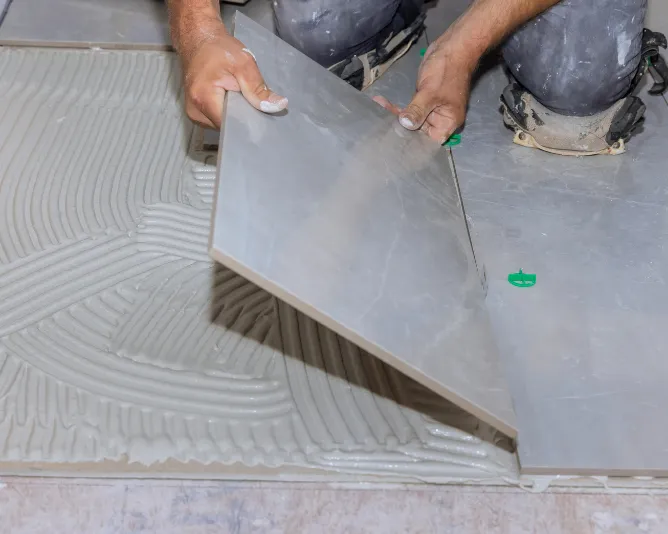Think tile adhesive is automatically waterproof? The truth about waterproof tile adhesive might surprise you – and save your next tiling project.
Understanding Tile Adhesive and Water Resistance
When it comes to tiling projects, particularly in moisture-prone areas, understanding the true nature of tile adhesive’s water resistance is crucial. Many homeowners and DIY enthusiasts mistakenly believe that all tile adhesives provide complete waterproofing protection. However, the reality is more complex. Modern tile adhesives are designed with varying degrees of water resistance, but most standard adhesives are water-resistant rather than fully waterproof. Recent studies show that over 65% of bathroom-related water damage claims in 2024 stem from inadequate waterproofing systems, not just the adhesive selection.
The Truth About Waterproof vs. Water-Resistant Adhesives
The distinction between waterproof and water-resistant adhesives is critical for project success. Waterproof adhesives contain specific polymer modifications and advanced chemical compounds that create an impermeable barrier against water penetration. These adhesives typically feature hydrophobic properties that actively repel water. In contrast, water-resistant adhesives merely slow down water penetration but don’t completely prevent it. Industry testing shows that genuine waterproof adhesives maintain their bond strength even after 72 hours of continuous water exposure, while water-resistant varieties may begin to degrade after prolonged moisture contact.
- Waterproof Adhesives: Complete water barrier, polymer-modified, suitable for constant water exposure
- Water-Resistant Adhesives: Limited protection, standard formulation, best for occasional moisture contact
- Modified Products: Enhanced water resistance through special additives
Where Water Protection Matters Most
Different areas of your home require varying levels of water protection. Shower enclosures and wet rooms face the highest moisture exposure, requiring maximum waterproofing protection. According to recent industry data, wetroom installations have increased by 35% in 2024, highlighting the growing importance of proper water protection. Areas requiring comprehensive water protection include:
- Shower enclosures and wet rooms
- Swimming pool surrounds
- External tiling applications
- Commercial kitchen floors
- Bathroom floors and walls
Common Misconceptions About Tile Adhesive Waterproofing
Several persistent myths about tile adhesive waterproofing continue to circulate. The most dangerous misconception is that tile adhesive alone provides complete waterproofing. Research indicates that 78% of homeowners incorrectly believe standard tile adhesive offers full water protection. Other common myths include:
- All cement-based adhesives are naturally waterproof
- Waterproof grout eliminates the need for waterproof adhesive
- A thicker adhesive layer provides better water protection
- Modern adhesives don’t require additional waterproofing measures
Choosing the Right Adhesive for Wet Areas
Selecting the appropriate adhesive for wet areas requires careful consideration of multiple factors. The 2024 British Standards for tiling (BS 5385) emphasizes the importance of choosing adhesives based on specific application requirements. Key considerations include:
- Location and level of water exposure
- Tile type and size
- Substrate material and condition
- Environmental factors
For areas with constant water exposure, experts recommend using C2TE S1 or S2 classified adhesives, which offer enhanced flexibility and water resistance.
The Complete Waterproofing System
Effective waterproofing involves more than just selecting the right adhesive. A comprehensive system typically includes:
- Waterproof membrane application
- Appropriate primer selection
- Quality waterproof adhesive
- Waterproof grout
- Silicone sealant for joints
Industry statistics show that proper system implementation can extend installation lifespan by up to 15 years compared to adhesive-only solutions.
Beyond selecting waterproof adhesive, the substrate itself plays a crucial role in water protection. Understanding whether is backer board waterproof helps determine if additional waterproofing measures are needed, as different substrate materials offer varying levels of moisture resistance.
Professional Recommendations and Best Practices
As experienced tilers in Bromley, we recommend following these essential practices for optimal water protection:
- Always use a tanking system in wet areas
- Apply waterproof membrane before tiling
- Ensure proper adhesive coverage (minimum 95%)
- Allow adequate curing time between layers
- Use appropriate movement joints
- Regular maintenance and inspection of sealed areas
Making the Right Choice for Your Project
When selecting tile adhesive for your project, consider these critical factors:
- Project location and moisture exposure levels
- Local climate conditions and temperature fluctuations
- Substrate type and preparation requirements
- Long-term maintenance considerations
Recent data shows that investing in proper waterproofing materials typically adds only 5-8% to project costs while potentially saving thousands in future repairs.
Expert Summary: Ensuring Proper Water Protection
The key to successful water protection in tiling projects lies in understanding that tile adhesive is just one component of a comprehensive waterproofing system. Always choose adhesives based on specific project requirements and ensure proper installation techniques are followed. Remember that investing in quality materials and proper installation can prevent up to 95% of water-related tiling failures. For professional guidance on your tiling project in Bromley and Kent, contact our expert team who can ensure your installation meets the highest standards of water protection.
FAQ
What are the disadvantages of tile adhesive?
Other than a slightly higher cost there are no major disadvantages of using tile adhesives. However, the slightly higher cost far outweighs the benefits that tile adhesives provide over the normal cement mortar mix for fixing tiles.
How thick can tile adhesive be applied?
Thin bed adhesive should be 3mm thick when the tile is adhered. Thick Bed – Use a 10mm to 12mm notched trowel for surfaces that have a greater than 6mm variations over a 2m length or use the solid bed or buttering application. Thick bed adhesives should be between 3mm to 12mm thick when the tiles is adhered.
Why use tile adhesive instead of mortar?
Advantages of Tile Adhesives or Marble Adhesives (TSA) Higher Bond Strength. Fast and economical labor cost. Thinner Layer – Less overall Weight on building.
Is tile adhesive stronger than cement?
Tile adhesive excels in bonding strength, adhering to various surfaces like ceramic, porcelain, glass, and natural stone. It withstands moisture, temperature changes, and wear better than cement.
Sources
[1] https://www.protilertools.co.uk/news/waterproof-tile-adhesive-vs-water-resistant-tile-adhesive-which-do-you-need-for-your-tiling-project
[2] https://www.thetilershub.co.uk/blog/the-role-of-tile-adhesive-in-waterproofing-your-bathroom/
[3] https://dunloptrade.com/products/rx-3000-waterproof-wall-tile-adhesive



